5 Bodyweight Exercises That Flatten Your Stomach Faster Than Gym Workouts After 50
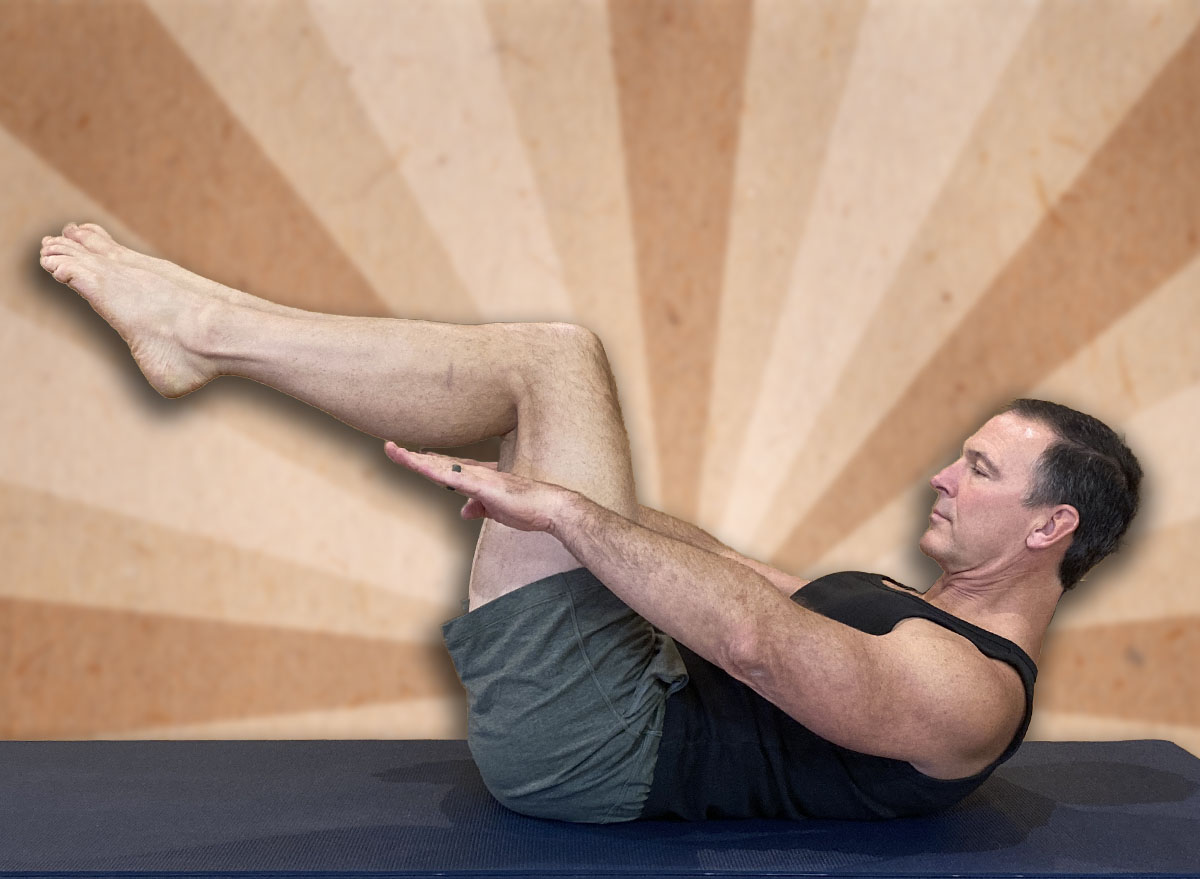
As we gracefully age, our bodies undergo a myriad of changes, and the midsection often becomes a primary concern. The quest for a flatter stomach doesn’t have to lead you to complex gym equipment or high-impact routines, especially after the age of 50. In fact, targeted bodyweight exercises, particularly those rooted in Pilates and calisthenics, can often be more effective, safer, and more convenient than traditional gym workouts.
As a seasoned trainer who has worked with clients over 50 for years, I’ve seen firsthand what truly works for this age group. Let’s explore why bodyweight exercises are so effective and discover five powerful movements you can do right at home.
What Happens to Your Stomach and Core After 50?

Before diving into the exercises, it’s helpful to understand why maintaining a flat stomach seems to get harder as we age:
- Your Hormones Change: For women, menopause leads to a significant drop in estrogen, which often causes a redistribution of fat from the hips and thighs to the abdominal area. For men, the decline in testosterone (T) is also a factor. Medical research shows that low testosterone levels are associated with increased central adiposity (belly fat) and reduced lean muscle mass. Furthermore, fat tissue contains an enzyme called aromatase that converts testosterone into estrogen, creating a vicious cycle that further promotes abdominal fat storage.
- You Lose Muscle Mass: After 30, we naturally start losing muscle mass, a process that accelerates after 50. Less muscle means a slower metabolism, making it easier to gain fat, especially around the core, and harder to burn it.
- Your Metabolism Slows Down: Our metabolic rate slows down with age. This means we burn fewer calories at rest, and if our caloric intake doesn’t adjust, weight gain, particularly around the abdomen, becomes more likely.
- Your Core Gets Weaker: A lifetime of habits, often involving prolonged sitting, can weaken the deep core muscles that support good posture and keep the abdomen tucked in. This can lead to a more protruded belly, even without significant fat gain.
- Visceral Fat Builds Up: This is a particularly stubborn type of fat that accumulates around internal organs. It’s not just cosmetic; it’s associated with increased health risks. Hormonal changes and inactivity contribute to its increase with age.
Why Bodyweight Exercises May Be Your Secret Weapon Over 50
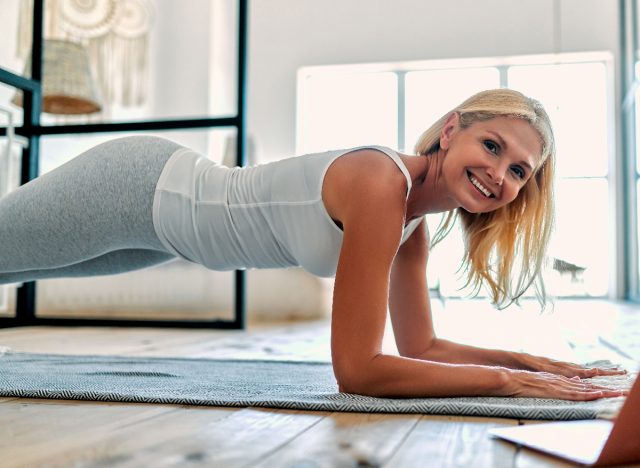
While gyms offer a range of equipment, bodyweight exercises often hold several advantages for individuals over 50 striving for a flatter stomach:
- They Work Your Deep Core: Pilates and calisthenics inherently emphasize engaging the deep core muscles (transverse abdominis, obliques, pelvic floor) that are crucial for a truly flat stomach and strong back. Many gym machines isolate specific muscles, potentially neglecting this vital deep core connection.
- They’re Easier on Your Joints: Bodyweight exercises are generally lower impact, making them gentler on aging joints that may be prone to arthritis or wear and tear.
- You Build Real-World Strength: These movements often mimic natural body movements, improving functional strength for everyday activities and enhancing balance and stability – critical as we age.
- You Can Do Them Anywhere: No equipment, no gym membership, no travel time. You can do them anytime, anywhere, making consistency much easier to maintain.
- You Connect Mind and Body: Pilates, in particular, promotes a powerful mind-body connection, which is crucial for maximizing core results. This is achieved through the core principles of mindfulness, concentration, and control. As a mind-body exercise, Pilates requires your full attention on precise muscle control, proper alignment, and coordinated, deep breathing, turning the workout into a form of active meditation that enhances body awareness and functional strength.
- Your Posture Improves: By strengthening the core stabilizers, bodyweight exercises naturally lead to better posture, which can make your stomach appear flatter instantly.
The Five Flattening Powerhouses
Here are five highly effective bodyweight exercises, inspired by Pilates and calisthenics, that will target your core and help you achieve a flatter stomach. Use a yoga mat, rug, or carpeted floor for cushioning and traction.
The Pilates Hundred (Modified)
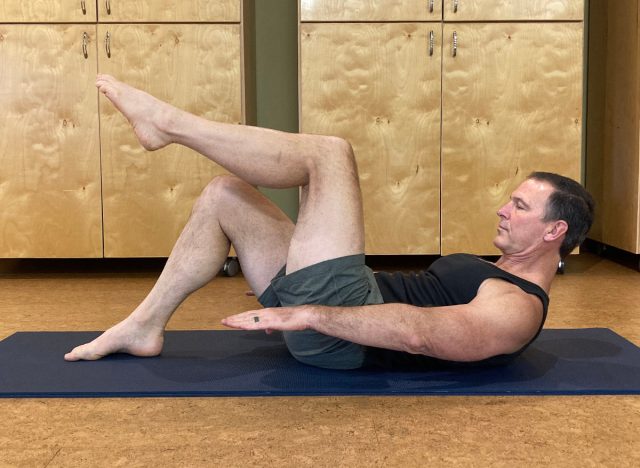
Why it works:
This exercise is a powerhouse for the transverse abdominis, the deepest abdominal muscle that acts like a natural corset, pulling the abdominal wall inward. The sustained contraction builds incredible core endurance, which is key for maintaining a flat belly throughout the day.
How to do it:
- Lie on your back with your knees bent, feet flat on the floor, and arms by your sides.
- Engage your core, drawing your navel towards your spine. Gently imprint your lower back against the mat.
- Draw one leg to a table top position, with the hip and knee flex to 90 degrees. Then lift the other leg to table top.
- Gently lift your head and shoulders off the mat, looking towards your thighs.
- Extend your arms straight out, hovering a few inches above the floor, palms facing down.
- Pump your arms up and down vigorously in small, controlled movements (about 6-8 inches), inhaling for five pumps and exhaling for five pumps.
- The goal is to complete 100 pumps (ten breaths).
Avoid these mistakes:
- Don’t Arch Your Back: This disengages the core and can strain your back. Ensure your lower back stays pressed into the mat.
- Don’t Strain Your Neck: The movement should come from your core, not your neck. If your neck aches, support your head with one hand or keep it on the floor.
- Don’t Breathe Too Shallow: Focus on deep, controlled breaths that fuel the exercise.
Tips for beginners:
- Keep your head on the floor and just perform the arm pumps while keeping your core engaged and lower back connected to the mat.
- Lift one leg to a tabletop position (knees and hips flexed at 90 degrees), and perform half of the hundred count, then switch legs and finish the set.
- Keep both feet on the mat, knees bent.
Bird-Dog with Elbow-to-Knee Crunch
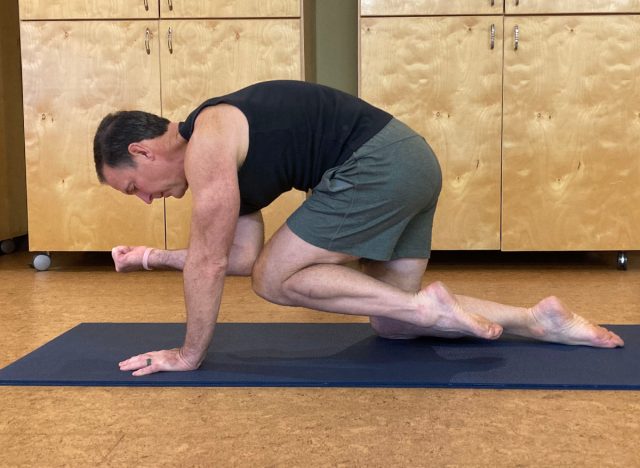
This exercise combines stability with a dynamic crunch, engaging multiple core muscles simultaneously.
Why it works: The extension phase works your deep core stabilizers and back extensors, improving postural support. The crunch brings in the rectus abdominis (six-pack muscles) and obliques, tightening the entire front and side of your core. It’s excellent for overall core control and stability.
How to do it:
- Start on all fours (hands directly under shoulders, knees directly under hips). Ensure your back is flat and the core is gently engaged.
- As you exhale, slowly extend your right arm forward and your left leg straight back, keeping them parallel to the floor. Maintain a stable, flat back, resisting any rotation.
- As you inhale, bring your extended right elbow and left knee towards each other under your torso, performing a gentle crunch and really squeezing your core.
- Extend back out to the starting position (arm forward, leg back).
- Return to all fours and repeat on the other side.
Avoid these mistakes:
- Don’t Over-Round Your Back: While your trunk will flex some during the crunch phase of the movement, focus on keeping your spine neutral and stable throughout the rest of the movement.
- Don’t Tilt Your Hips: The goal is to keep your hips level and square to the floor.
- Don’t Rush the Movement: Control and precision are more important than speed.
Tips for beginners:
- Perform the Bird-Dog extension only, without the elbow-to-knee crunch. Focus purely on stability.
- Keep your foot on the ground as you slide your leg back, rather than lifting it.
Pilates Roll-Up (Modified)
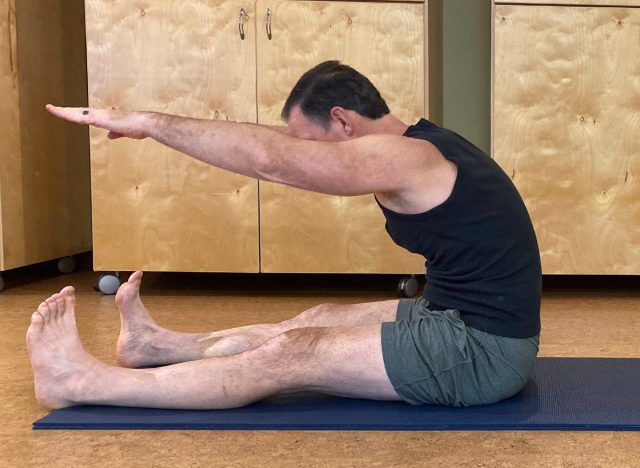
The Roll-Up is a fantastic way to articulate the spine and strengthen the entire anterior core chain.
Why it works: This exercise provides a deep, controlled engagement of the rectus abdominis and obliques through a full range of motion. It also improves spinal flexibility, which can indirectly help with posture and a flatter appearance. The slow, controlled movement prevents momentum from taking over, ensuring your core does the work.
How to do it:
- Lie on your back with your legs extended straight, feet flexed, and arms extended straight overhead (or behind your head if more comfortable).
- Inhale as you bring your arms up towards the ceiling, then begin to slowly lift your head and shoulders off the mat.
- Exhale as you continue to peel your spine off the mat, one vertebra at a time, reaching your hands towards your toes. Keep your core deeply engaged, drawing your navel towards your spine to control the movement.
- Once you’ve reached your maximum stretch forward, inhale and begin to slowly roll back down, articulating your spine one vertebra at a time, until your head returns to the mat.
Avoid these mistakes:
- Don’t Use Momentum: The goal is slow, controlled movement, not just getting up.
- Don’t Hold Your Breath: Coordinate your breath with the movement – inhale to prepare, exhale to roll up.
- Don’t Strain Your Neck: Focus on initiating the movement from your core, not by yanking your head up.
Tips for beginners:
- Half Roll-Down: Start from the seated, flexed-forward position, and slowly control your lowering toward the mat. This is a great way to build strength in abdominals and hip flexors.
- Half Roll-Up: Only roll up halfway until your shoulder blades lift off the floor, then slowly roll back down.
- Use a Towel/Band: Hold a towel or resistance band around your feet for assistance as you roll up and down.
Plank with Hip Dips
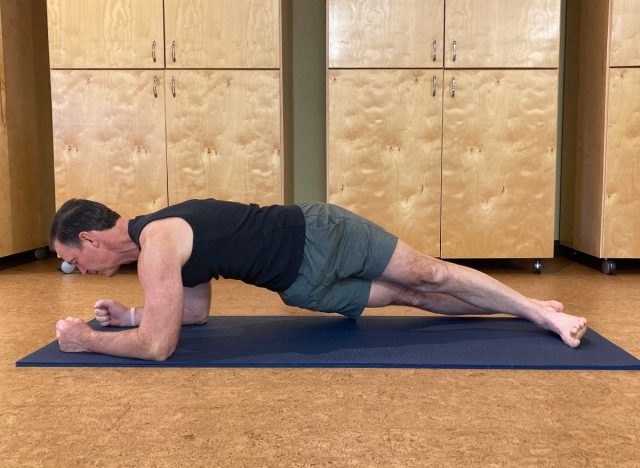
The plank is a foundational core exercise, and adding hip dips intensifies the oblique engagement.
Why it works: The standard plank is excellent for strengthening the entire core (transverse abdominis, rectus abdominis, obliques, and lower back muscles) for stability. Adding the hip dips specifically targets the internal and external obliques, the muscles on the sides of your waist that help create a cinched, flatter appearance.
How to do it:
- Start in a forearm plank position: forearms on the floor, elbows directly under shoulders, body in a straight line from head to heels. Engage your core, glutes, and quadriceps.
- Keeping your body as straight as possible, gently drop your right hip towards the floor.
- Return to the center plank position.
- Now, gently drop your left hip towards the floor.
- Return to the center plank. Alternate sides, maintaining core control.
Avoid these mistakes:
- Don’t Let Your Hips Sag: Keep your hips in line with your shoulders and heels in the plank position.
- Don’t Arch Your Back: Maintain a neutral spine; avoid letting your lower back collapse.
- Don’t Rush the Dips: Control the movement; it’s not about how far you dip, but how much you engage your obliques to control the return.
Tips for beginners:
- Perform a standard forearm plank without the hip dips, holding for time.
- Perform the plank on your knees (forearms on the floor, knees on the floor, body in a straight line from head to knees).
- Reduce the depth of the hip dip, focusing on just a small rotation.
Leg Lowers (Single or Double)
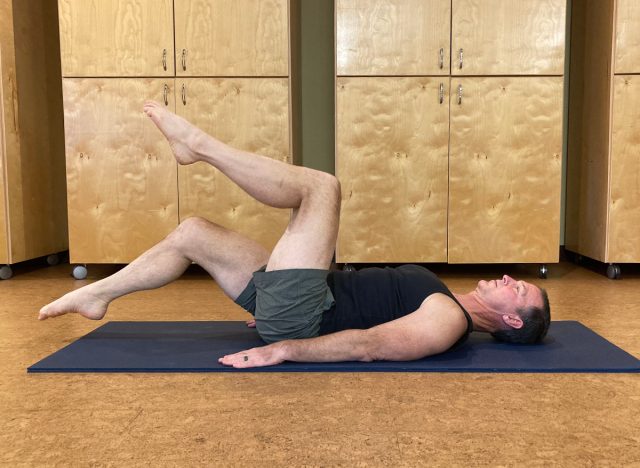
This Pilates exercise is incredibly effective for strengthening the lower abs and controlling the pelvis.
Why it works: Leg lowers are phenomenal for isolating and strengthening the lower rectus abdominis and the deep transverse abdominis. By controlling the descent and ascent of your legs, you’re challenging these muscles to stabilize your pelvis and prevent your lower back from arching, which is a key component of a strong, flat core.
How to do it:
- Lie on your back with your knees bent, feet flat. Engage your core and gently imprint your lower back into the mat.
- Lift both legs to a tabletop position (knees bent at 90 degrees directly over hips), one at a time.
- (For Single Leg Lower – Beginner/Intermediate) Slowly lower and lengthen one leg towards the floor while keeping the other in tabletop. Only lengthen and lower as far as you can while keeping the low back imprinted on the mat.
- (For Double Leg Lower – Advanced) Slowly lower and lengthen both legs towards the floor, keeping them together. Only lengthen and lower as far as you can while keeping the low back imprinted on the mat.
- Engage your lower abs to slowly bring the leg(s) back up to the tabletop position.
- As you build strength in your abdominals and can better stabilize the lower back, during the movement you can start to lengthen the leg(s) by degrees as your lower and then draw them to table top as you lift.
Avoid these mistakes:
- Don’t Arch Your Lower Back: This is the most critical mistake. If your back arches, you’ve gone too far. Reduce your range of motion immediately.
- Don’t Hold Your Breath: Exhale as you lower the legs, inhale as you bring them up.
- Don’t Use Momentum: The movement should be slow and controlled, both down and up.
Tips for Beginners:
- Single Leg Lower: As described above, this is much easier to control. You can alternate legs or do all reps on one and then repeat with the other leg
- Smaller Range of Motion: Only lower the legs a few inches, rather than all the way down.
- Bent Knees: Keep your knees bent at 90 degrees throughout the movement (like tapping your toes to the floor) to reduce the leverage and make it easier.
How Often to Practice

Frequency: For optimal results and to allow for recovery, aim to perform these exercises 3-4 times per week on non-consecutive days. This gives your muscles time to repair and strengthen.
Suggested Sets and Reps:
- Pilates Hundred: 1–2 sets, aiming for 10 full breaths (100 pumps).
- Bird-Dog Crunch: 2–3 sets of 8-10 repetitions per side.
- Pilates Roll-Up: 2–3 sets of 4-6 repetitions.
- Plank with Hip Dips: 2–3 sets, holding for 30–60 seconds, or 8-10 dips per side.
- Leg Lowers (Single or Double): 2–3 sets of 8–12 repetitions per leg (single) or total (double).
What to Expect in 4-6 Weeks:

While individual results vary, within 4 to 6 weeks of consistent practice, you can realistically expect:
- Your Core Gets Stronger: You’ll notice it’s easier to hold a plank or perform other core-intensive tasks.
- You’ll Stand Straighter: Your body will naturally hold itself more upright, which can instantly make your stomach appear flatter.
- You Become More Body Aware: You’ll become more attuned to engaging your core throughout the day.
- Your Balance Improves: Everyday movements will feel more controlled.
- Your Midsection Feels Firmer: While significant fat loss takes longer, your midsection will feel more taut and toned.
It’s important to manage expectations regarding visible “flatness” in this timeframe. While strength and tone will improve, significant changes in body fat percentage, which is the primary driver of a truly flatter stomach, require a broader approach.
Don’t Forget About Your Diet
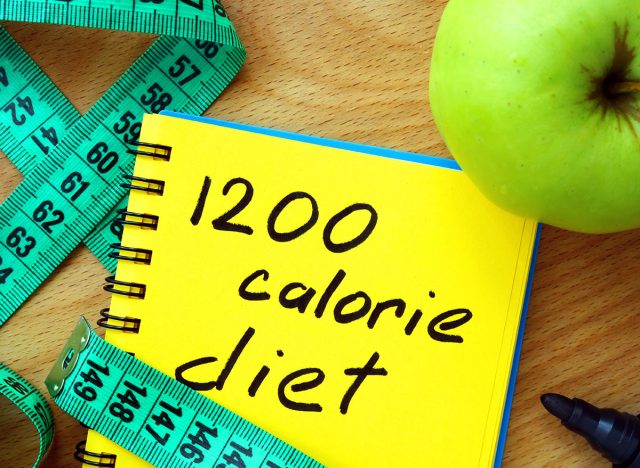
No amount of exercise, no matter how targeted, can completely counteract an unhealthy diet. Diet is arguably the most critical factor when it comes to reducing abdominal fat, especially after 50.
- Calorie Deficit: To lose fat, you must consistently consume fewer calories than you burn. Even small, consistent deficits lead to fat loss over time.
- Prioritize Protein: Increase intake of lean protein. It helps preserve muscle mass (counteracting sarcopenia), keeps you feeling full, and requires more energy to digest.
- Fiber is Key: Vegetables, fruits, and whole grains are rich in fiber, which aids digestion, promotes satiety, and can help reduce belly bloat.
- Limit Processed Foods & Sugar: These are often high in empty calories, unhealthy fats, and can contribute to inflammation and stubborn belly fat.
- Stay Hydrated: Drinking plenty of water is essential for metabolism, digestion, and can help prevent confusing thirst for hunger.
- Reduce Alcohol: Alcohol contributes to empty calories and can specifically encourage abdominal fat storage.
Think of it this way: these bodyweight exercises are like sculpting the muscle underneath. But to reveal that sculpture, you need to chip away the outer layer of fat, and that’s primarily done through consistent, mindful nutrition.
References:
Source for Hormonal Changes and Belly Fat (Low Testosterone)
Source Title: Lowered testosterone in male obesity: mechanisms, morbidity and management
Institution/Publication: PMC – PubMed Central (National Institutes of Health/U.S. National Library of Medicine)
Web Link: https://pmc.ncbi.nlm.nih.gov/articles/PMC3955331/
Annotation: This source supports the claim that low testosterone levels in men are frequently encountered in obese men and lead to increased adiposity, creating a “self-perpetuating cycle of metabolic complications.” It specifically mentions the role of fat tissue and its conversion of testosterone.
Source for Pilates and the Mind-Body Connection
Source Title: Somatic Education and Mind-Body Disciplines: Exploring the Effects of the Pilates Method on Life Satisfaction, Mindfulness and Self-Compassion
Institution/Publication: ResearchGate / Journal of Educational and Social Research
Annotation: This research article supports the explanation of the mind-body connection in Pilates, noting that the method requires “complete mental focus” and positively correlates with factors that enhance mindfulness and concentration, helping practitioners make a conscious connection with their movements and breath.
Source for Sarcopenia and its Impact on Metabolism:
Source Title: Sarcopenia and Its Implications for Metabolic Health
Institution/Publication: PMC – PubMed Central (National Institutes of Health/U.S. National Library of Medicine)
Web Link: https://pmc.ncbi.nlm.nih.gov/articles/PMC6431367/
Annotation: This scientific review directly supports the description of age-related muscle loss (sarcopenia) and its metabolic consequences. It confirms that the loss of muscle mass accelerates after the fifth decade (age 50), with 30–40% of muscle potentially lost between 50 and 80 years. This loss reduces resting energy expenditure (REE), which is the definition of a slower metabolism. This reduced energy expenditure leads to an increase in fat mass, contributing to obesity, particularly the harmful visceral fat often stored around the core. The study also notes that lost muscle tissue may be replaced directly by fat.
- Source: https://pmc.ncbi.nlm.nih.gov/articles/PMC3955331/
- Source: https://www.researchgate.net/publication/361837669_Somatic_Education_and_Mind-Body_Disciplines_Exploring_the_Effects_of_the_Pilates_Method_on_Life_Satisfaction_Mindfulness_and_Self-Compassion
- Source: https://pmc.ncbi.nlm.nih.gov/articles/PMC6431367/